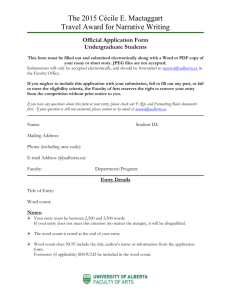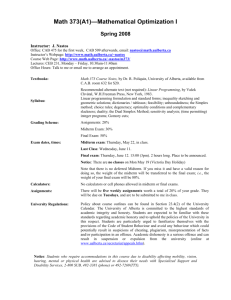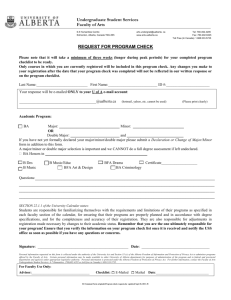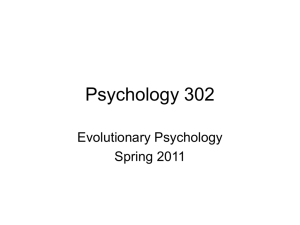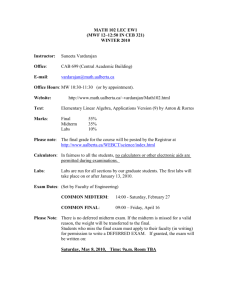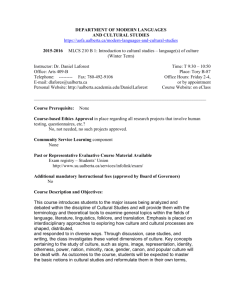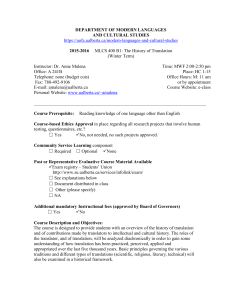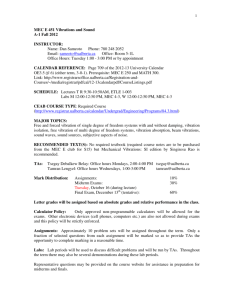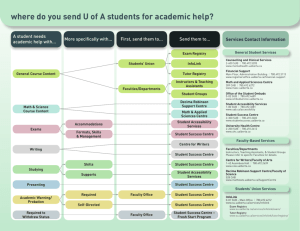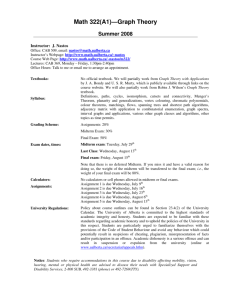Introductory Microbiology
advertisement
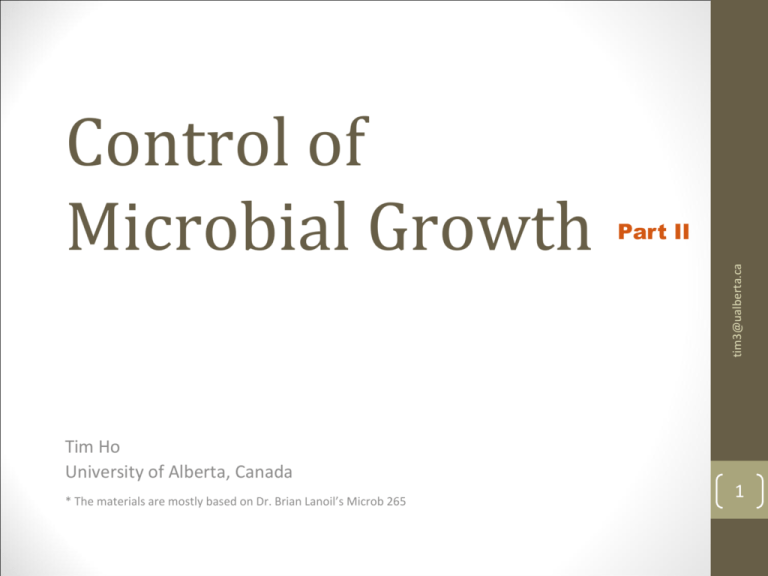
Part II tim3@ualberta.ca Control of Microbial Growth Tim Ho University of Alberta, Canada * The materials are mostly based on Dr. Brian Lanoil’s Microb 265 1 Objectives • Physical agents • Mechanical removal methods • Chemical agents 2. Know the strategies on how drugs control the growth of microorganisms. 3. Understand how do bacteria become resistant to antibiotics. tim3@ualberta.ca 1. Know 3 methods of microbial control 2 Characteristics of antimicrobial drugs: 2. Therapeutic dose: the amount of drug required for treatment or the desired effect. 3. Broad spectrum activity: against a wide variety of pathogens or do not know the specific bacteria that want to target. tim3@ualberta.ca 1. With minimal side effects 4. Chemotherapeutic agents can be synthetic or semi-synthetic. 3 Dilution Susceptibility test • Each test tube containing different concentrations of drug - MIC: minimum inhibitory concentration - MLC: minimum lethal concentration high [drug] tim3@ualberta.ca Low [drug] + + + + + + + - - - 4 Disk diffusion test • Kirby-Bauer method • Measure the diameter of clear zone (no growth) around disks -> determine MIC and MLC tim3@ualberta.ca • Drug diffuses from disk into agar, establishing concentration gradient Large clear zone = sensitive No or small clear zone = resistant 5 Image:http://www.biotopics.co.uk/microbes/penici.html tim3@ualberta.ca Disk diffusion test 6 Image:http://www.biotopics.co.uk/microbes/penici.html tim3@ualberta.ca How different types of antibiotics affect cell functions 7 tim3@ualberta.ca Folic acid synthesis inhibitors 8 Folic acid synthesis inhibitors Sulfanilamide: - Competitive inhibitor of PABA tim3@ualberta.ca Image: Fdardel, 2011 - [PABA] ↑= rate of folic acid biosynthesis ↓ 9 tim3@ualberta.ca DNA gyrase inhibitors 10 DNA gyrase inhibitors Ciprofloxacin Image: Drug Reference - Encyclopedia Quinolones: tim3@ualberta.ca DNA gyrase: the enzyme that introduces negative supercoils into DNA - inhibit bacterial DNA gyrase - effective against G- urinary tract infections and respiratory infections - (eg. Bacillus anthracis) 11 tim3@ualberta.ca RNA synthesis inhibitors 12 RNA synthesis inhibitors Rifamycin/ Rifampin: - Not selectively toxic → Prokaryotes and eukaryotes synthesize nucleic acids in pretty much the same way tim3@ualberta.ca - block transcription by binding RNA polymerase 13 Cell wall synthesis inhibitors WHY: ß-lactamases have higher binding affinity for clavulanic acid than ampicillin tim3@ualberta.ca - Ampicillin is protected from lactamases by co-treatment with clavulanic acid 14 Image: Dengler et al. BMC Microbiology 2011 11:16 doi:10.1186/1471-2180-11-16 Cell wall synthesis inhibitors G + bacteria are more susceptible to ß-lactam antibiotics!! (transpeptidase) It breaks ß-lactam rings: antibiotic resistance - G+ cells: ß-lactamases are located on outside surface G- cells: ß-lactamases are in periplasmic space tim3@ualberta.ca Activity is blocked by binding to transpeptidases 15 Image: Insilico Genomics Lab Technologies. http://insilicogenomics.in/penicillin.asp Cell wall synthesis inhibitors tim3@ualberta.ca blocks dephosphorylation of bactoprenol phosphate blocks transpeptidization blocks D-Ala peptidization Image: Dengler et al. BMC Microbiology 2011 11:16 doi:10.1186/1471-2180-11-16 16 tim3@ualberta.ca Protein synthesis inhibitors 17 Protein synthesis inhibitors Macrolides: -Binding to the large subunit ribosome - First broad-spectrum antibiotics -Blocking tRNA attachment to ribosome - effective against G- and G+ cells tim3@ualberta.ca Tetracyclines: Aminoglycosides: -Binding to the small subunit ribosome - effective against G- cells 18 tim3@ualberta.ca Cytoplasmic membrane inhibitors 19 Cytoplasmic membrane inhibitors Daptomycin: - Makes pore on cytoplasmic membrane - Resistance from changes in cell membrane structure tim3@ualberta.ca - Cyclic lipopeptide - Primarily targets G+ cells (G- cells have extra outer membrane: protection) 20 Anti-fungal Drugs • Fungal infections are difficult to treat - host and pathogen have biological similarity • Target against chitin (fungal cell wall) mostly - animals (host) don’t have chitin • Nystatin: first discovered antifungal antibiotic in 1949 by Hazen and Brown tim3@ualberta.ca → drug can harm host at the same time • Superficial mycoses - Infections of outer layers of skin - Treatment (drugs): Miconazole, Nystatin, and Griseofulvin - Minimizes toxic systemic side effects (e.g. liver damage) 21 Antiviral Drugs • Many drugs are still in development stage - Structural analogs of purine or pyrimidine bases - difficulties: viruses use metabolic machinery of the host • Protease inhibitors: against virus-specific enzymes tim3@ualberta.ca • Mainly target against either RNA or DNA synthesis of viral pathogen • Interferons: stimulate production of host anti-viral proteins 22
